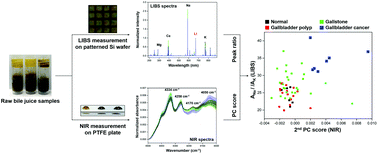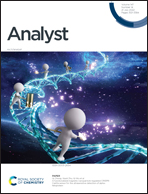Combination of LIBS-based elemental analysis and near-infrared molecular fingerprinting of bile juice to enhance identification of gallbladder cancer†
Abstract
Laser-induced breakdown spectroscopy (LIBS) and near-infrared (NIR) spectroscopy, enabling the measurement of raw bile directly without sample pretreatment, were cooperatively combined to enhance the discrimination of gallbladder cancer (GBC) from other diseases of gallstone and gallbladder (GB) polyp. Since elemental contents and metabolite compositions of bile vary according to the pathological conditions of pancreaticobiliary patients, the use of complementary information could be synergetic to improve disease identification accuracy. The ratios of Mg and Na peak areas (AMg/ANa) and Na and K peak areas (ANa/AK) in the LIBS spectra of GBC samples were different from those of the remaining samples. Also, the intensity ratios of main NIR peaks differed in GBC. Nonetheless, the use of only element peak area ratio or NIR peak intensity ratio was not sufficient to clearly discriminate GBC. On the other hand, when the ANa/AK values and second NIR principal component scores were combined, the discrimination of GBC from normal/gallstone/GB polyp was substantially enhanced owing to incorporation of both complementary GBC-discriminant spectroscopic signatures.



 Please wait while we load your content...
Please wait while we load your content...